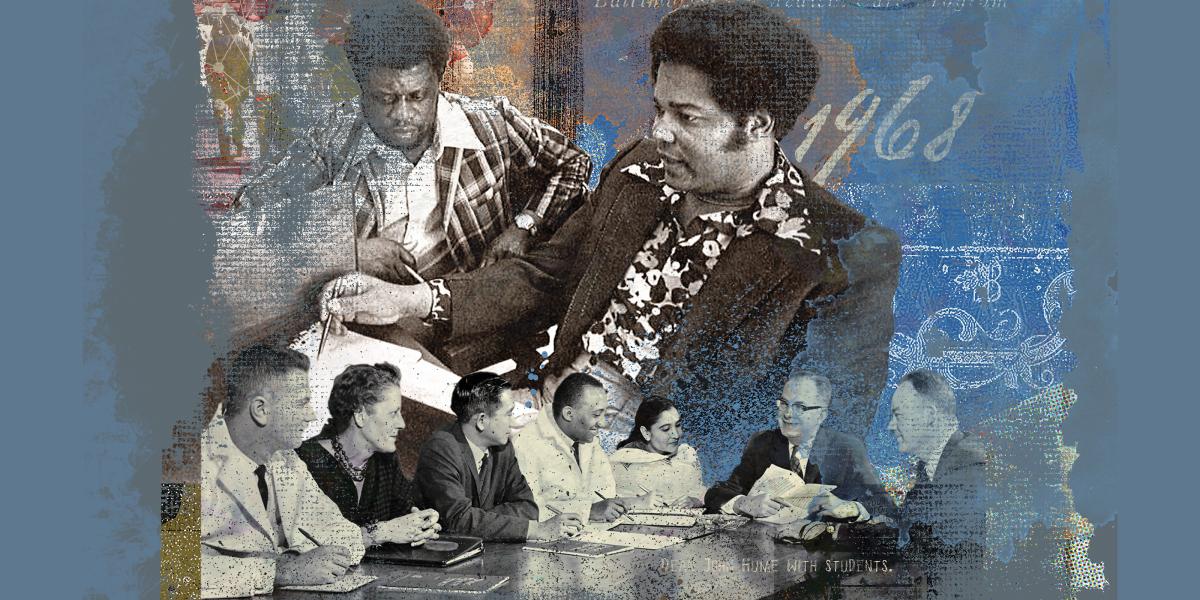The Honeymoon Is Over
Turning Points | Four defining moments in the history of the Bloomberg School
During the 1960s, the health sector of the U.S. economy grew from $25 billion to $60 billion, a 30 percent increase in the share of gross national product. But 1968 marked a major political and administrative turning point for all health-related federal agencies, particularly the Public Health Service. Federal support for public health lost two of its most influential longtime patrons: Senator Lister Hill retired after 14 years as chair of the Health Appropriations Subcommittee; and Congressman John E. Fogarty died. The 1968 reorganization of the Department of Health, Education and Welfare separated the NIH as an independent agency from the PHS, which transferred many of its traditional duties to the Food and Drug Administration and, two years later, to the Environmental Protection Agency. Dean John Hume remarked in the 1967–68 JHSPH annual report that 1968 had been “marked by an abrupt shift of priorities in the Federal Government and the rude awakening of the health professions to the fact that the ‘honeymoon is over.’”
These changes hit with particular force at Johns Hopkins, the top federal grant recipient among schools of public health. From 1960 to 1970, the Hill-Rhodes federal traineeships had helped JHSPH enrollments expand by 160 percent. Yet the school’s annual expenditures had ballooned by 460 percent, and the school’s own 10-year plan acknowledged that lack of hard support for faculty was “a major weakness,” since JHSPH had been unable to muster sufficient long-term nongovernmental general support “to guarantee a continued high quality of instruction to all our students.”
JHU President Milton Eisenhower observed that federal grants had resulted in “a tendency toward haphazard, unplanned growth.” Between 1962 and 1970, JHSPH created eight new departments; during the following seven years, 10 of the school’s departments underwent mergers to form four departments, resulting in a net gain of only two departments. Federal funds represented 86 percent of JHSPH revenue versus 53 percent of the university’s, and the school’s leadership declared, “It is obvious that such dependence on federal funds jeopardizes the School’s ability to maintain its independence in establishing its own academic priorities. If it is to remain an independent, private institution, a more favorable ratio of unrestricted, private support to public funding must be secured.”
After Lyndon Johnson declined to accept the Democratic nomination for re-election, Vice President Hubert Humphrey suffered a razor-thin loss to Richard M. Nixon. The reversal of Democratic fortunes resulted from a backlash against U.S. involvement in the Vietnam War and the breakdown of civil order at home, most visibly during the riots following Martin Luther King Jr.’s assassination in April and at the Democratic National Convention in Chicago that August. As a U.S. Senator and Johnson’s right hand, Humphrey had been a great friend to JHSPH, and his defeat was a serious blow for the school.
Humphrey and JHSPH both responded to the changing political winds by redoubling their efforts in support of domestic health programs. Humphrey reclaimed his Senate seat and helped lead the push to authorize the Women, Infants and Children (WIC) federal nutrition program on a trial basis in 1972. WIC, modeled in part on a Baltimore program established by JHSPH pediatrician David Paige, was the rare social welfare program that appealed to both big-government liberals and farm-state conservatives. The school’s subsequent expansion in three areas—the planning and evaluating of government medical care programs, reproductive and child health, and substance abuse prevention and treatment—corresponded to policy areas championed by Humphrey and his allies.
-
1970
Sol Levine, chair of Behavioral Sciences, stresses social factors in the etiology of heart disease.
-
1970
The Department of Population and Family Health splits into Maternal and Child Health, and Population Dynamics.
-
1973
Biochemist Bacon F. Chow promotes a protein-rich diet for healthy pregnancy and birth outcome
-
1975
Lawrence Green shows that a planned health education program can decrease death from hypertension.
-
1976
Associate Dean Harvey Fischman establishes the undergraduate track in public health at Homewood.
-
1976
Environmental Health merges with Environmental Medicine to form the Department of Environmental Health Sciences.
-
1977
Bernice Cohen, Earl Diamond and co-authors show that family history of cancer and COPD increases disease risk, even in non-smokers.
-
1977
JHSPH leads the university in appointing the first female associate dean: Edyth Schoenrich.
-
1978
Jacqueline Agnew founds the Occupational and Environmental Medicine Residency.
-
1979
Susan Baker documents high rates of infant deaths in car crashes and advocates for child safety restraint laws.
A CATALYST FOR PRIMARY CARE
The national unrest leading up to and including the 1968 Baltimore riots enabled East Baltimore community activists to convince the city and Johns Hopkins to establish prepaid primary health care programs and expand Medicaid enrollment. JHSPH faculty helped the city and state health departments to improve responsiveness and efficiency on issues such as Medicaid financing; nursing home and hospital patient safety; and community-based health services for psychiatry, substance abuse and maternal and child health. By providing a catalyst for community concerns about health care access to be heard and addressed, the 1968 riots also helped to create an atmosphere in which JHSPH could conduct survey research with the cooperation of East Baltimore residents. These efforts helped advance primary care nationally and abroad by developing population-level, evidence-based methods to close racial and socioeconomic gaps in the quality and accessibility of health care.
